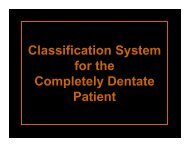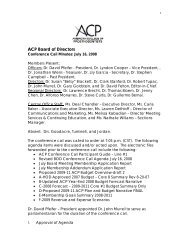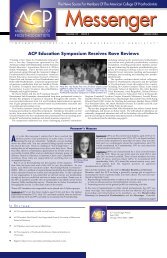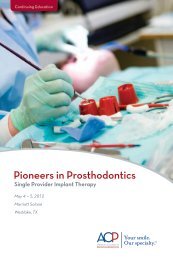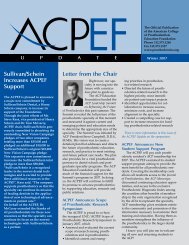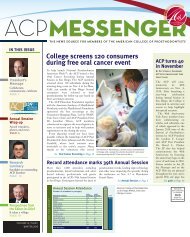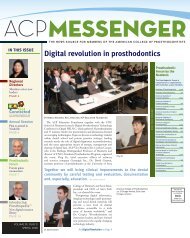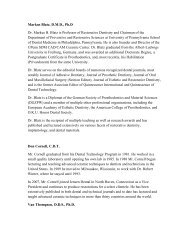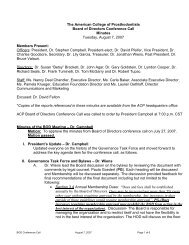PROSTHODONTICS - American College of Prosthodontists
PROSTHODONTICS - American College of Prosthodontists
PROSTHODONTICS - American College of Prosthodontists
You also want an ePaper? Increase the reach of your titles
YUMPU automatically turns print PDFs into web optimized ePapers that Google loves.
The <strong>American</strong> <strong>College</strong> <strong>of</strong> <strong>Prosthodontists</strong>Dental implants were introduced several decades ago and in fact, when first introduce inNorth America, their use as promoted by industry was restricted to Oral Surgeons and<strong>Prosthodontists</strong>. Thus, implants as a technology for tooth replacement therapy have been part<strong>of</strong> the specialty <strong>of</strong> prosthodontics since the early 1980’s and well before. In the last 10 years,several important innovations in dental implant therapy have advanced the specialty <strong>of</strong>prosthodontics.As mentioned above, the role <strong>of</strong> CBCT imaging and the inherent need for imagingprostheses (stents/guides) involves prosthodontics and prosthodontists at the inception and end<strong>of</strong> this diagnostic procedure for dental implant placement and restoration. One further pointabout this technological change is that present advances not yet in the market place includepre-surgical planning <strong>of</strong> abutments and final prostheses. This is made available by the merging<strong>of</strong> scanning information from the dental laboratory and the clinic and there joining in threedimensional models. The simplest way to perform this is through double scanning technologiesdeveloped for tooth replacement using implants for immediate loading protocols popularized as“teeth in a day” protocols. <strong>Prosthodontists</strong> have refined these technologies that enable thebetter implant therapy and patient care.Among the procedures in implant dentistry there has been increasing interest in early andimmediate loading <strong>of</strong> implants. Immediate loading is the process <strong>of</strong> placing an implant and animplant supported restoration at one time. There must be an integrated plan as well asintegrated thinking about the biology <strong>of</strong> implant wound healing <strong>of</strong> bone and mucosa, occlusionand esthetics. Advances in all aspect <strong>of</strong> knowledge have been achieved in this decade withwide participation <strong>of</strong> prosthodontists. The commitment <strong>of</strong> prosthodontists to Evidenced BasedDentistry is demonstrated in this field as several prospective comparative clinical trials havebeen published in support <strong>of</strong> immediate loading for specific conditions and other clinical trialsare ongoing and have been reported at national and international meetings. Systematic review<strong>of</strong> the literature (Jokstad 2007) supported the concept <strong>of</strong> immediate loading <strong>of</strong> implants placedin the anterior mandible but was unable to identify scientific support for immediate loading inother anatomic areas. Irrespective <strong>of</strong> the data set, immediate loading is part <strong>of</strong> the practice <strong>of</strong>implant dentistry. Its proper deployment as one strategy requires ongoing investigation, carefulplanning and education <strong>of</strong> the broader community <strong>of</strong> dentists. The <strong>American</strong> <strong>College</strong> <strong>of</strong><strong>Prosthodontists</strong> is committed to support <strong>of</strong> all <strong>of</strong> these activities related to this mode <strong>of</strong> treatmentand other emerging therapies in dentistry.The spectrum <strong>of</strong> care provided for using dental implants is changing. This decade hasseen a strong push by the prosthodontic community to improve care <strong>of</strong> the edentulous patient.In the summer <strong>of</strong> 2008, the ACP with support <strong>of</strong> industry presented to the internationalcommunity at the FDI meeting in Stockholm, the current concepts and challenges in treatment<strong>of</strong> edentulism. This information was also published in the Journal <strong>of</strong> Prosthodontics in 2009.The community <strong>of</strong> interest has developed enthusiasm for treatment <strong>of</strong> edentulism using minimalnumbers <strong>of</strong> implants for overdentures. An international consensus conference has identified themandibular implant supported overdenture as the standard <strong>of</strong> care for management <strong>of</strong> theedentulous mandible (Feine IJP 2002). <strong>Prosthodontists</strong> are now educated in thecomprehensive management <strong>of</strong> edentulism that includes the surgical placement <strong>of</strong> implants.Materials science related to Prosthodontics has been focused on ceramics. The use <strong>of</strong>pressed and milled materials is driven by the public focus on esthetics. Diverse materials havebeen studied and among them zirconia has drawn greatest attention. Zirconia <strong>of</strong>fers thepossibility for multiunit prosthesis (fixed dental prosthesis) where other materials haveinsufficient strength for broad based application. Related to the evolution <strong>of</strong> ceramics, thebonding <strong>of</strong> these different materials continues to be explored. Adhesive bonding to enamel andto a lesser degree to dentin has been reconsidered in the context <strong>of</strong> zirconia, lithium disilicateand leucite reinforced ceramic materials. Organized prosthodontics is part <strong>of</strong> this evolutionthrough its support <strong>of</strong> basic research, clinical research and dissemination <strong>of</strong> current information.For example, the ACP sponsored in April 2010 a conference entitled “The Art and Science <strong>of</strong>Modern Dental Ceramics 2010” where 20 expert clinicians <strong>of</strong>fered scientific fact and expertopinion regarding these matters.Prosthodontics - 112010 CDEL Re-recognition <strong>of</strong> the Specialty Report 11 <strong>of</strong> 279



